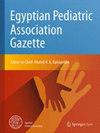建议在MRI系统上使用FLAIR图像诊断复发性卒中样发作的儿童MELAS,不能采用ASL成像
IF 0.5
Q4 PEDIATRICS
引用次数: 0
摘要
动脉自旋标记(ASL)成像是目前诊断线粒体脑肌病、乳酸酸中毒和卒中样发作综合征(MELAS)最有用的方法。然而,ASL通常是标准MRI系统的可选功能。因此,并非所有MRI系统都能进行ASL成像。相比之下,流体衰减反转恢复(FLAIR)成像是脑MRI中常见的序列之一,因为FLAIR成像可以在不考虑设备规格的情况下进行。本研究旨在比较液体衰减反转恢复(FLAIR)图像与ASL图像信号强度定量分析对MELAS伴复发性卒中样发作(SLEs)的诊断效果。本研究共纳入68例磁共振成像正常的患者和25例经诊断为MELAS的复发性SLEs患者。我们评估了额叶和楔叶作为靶区,并将ASL图像获得的区域脑血流(rCBF)值与FLAIR图像获得的归一化信号强度(nSI)进行了比较。结果rCBF线性判别分析(LDA)诊断MELAS的敏感性和特异性分别为0.84和0.941,nSI诊断MELAS的敏感性和特异性分别为0.8和0.897。采用rCBF值和nSI进行受试者工作特征(ROC)曲线分析计算得到的ROC曲线下面积(AUC)分别为0.889和0.804。结论FLAIR图像信号强度定量分析与ASL图像rCBF值诊断效果相当。本文章由计算机程序翻译,如有差异,请以英文原文为准。
Proposal for diagnosis using FLAIR image aimed for pediatric MELAS with recurrent stroke-like episodes on MRI system cannot take ASL imaging
Abstract Background Arterial spin-labeling (ASL) imaging is currently the most useful method for diagnosing mitochondrial encephalomyopathy, lactic acidosis, and stroke-like attack syndrome (MELAS). However, ASL is often an optional feature of standard MRI systems. Therefore, not all MRI systems can perform ASL imaging. In contrast, fluid-attenuated inversion recovery (FLAIR) imaging is one of the common sequences in brain MRI because FLAIR imaging can be performed regardless of the specifications of the equipment. This study aimed to compare the diagnostic performance of quantitative analysis of signal intensity obtained from fluid-attenuated inversion recovery (FLAIR) images with ASL images for MELAS with recurrent stroke-like episodes (SLEs). A total of 68 cases with normal magnetic resonance imaging findings and 25 cases diagnosed MELAS with recurrent SLEs were included. We evaluated the frontal lobe and cuneus as target areas and compared the regional cerebral blood flow (rCBF) values obtained from ASL images with the normalized signal intensity (nSI) obtained from FLAIR images. Results The sensitivity and specificity for diagnosing MELAS from linear discriminant analysis (LDA) obtained from the rCBF values were 0.84 and 0.941, respectively, and those of nSI were 0.8 and 0.897, respectively. The area under the ROC curves (AUC) calculated from the receiver operating characteristic (ROC) curve analysis using rCBF values and nSI were 0.889 and 0.804, respectively. Conclusion Quantitative analysis using the signal intensity of the FLAIR image could have a diagnostic performance equivalent to that of rCBF values obtained from ASL images.
求助全文
通过发布文献求助,成功后即可免费获取论文全文。
去求助
来源期刊

Egyptian Pediatric Association Gazette
PEDIATRICS-
自引率
0.00%
发文量
32
审稿时长
9 weeks
期刊介绍:
The Gazette is the official journal of the Egyptian Pediatric Association. The main purpose of the Gazette is to provide a place for the publication of high-quality papers documenting recent advances and new developments in both pediatrics and pediatric surgery in clinical and experimental settings. An equally important purpose of the Gazette is to publish local and regional issues related to children and child care. The Gazette welcomes original papers, review articles, case reports and short communications as well as short technical reports. Papers submitted to the Gazette are peer-reviewed by a large review board. The Gazette also offers CME quizzes, credits for which can be claimed from either the EPA website or the EPA headquarters. Fields of interest: all aspects of pediatrics, pediatric surgery, child health and child care. The Gazette complies with the Uniform Requirements for Manuscripts submitted to biomedical journals as recommended by the International Committee of Medical Journal Editors (ICMJE).
 求助内容:
求助内容: 应助结果提醒方式:
应助结果提醒方式:


